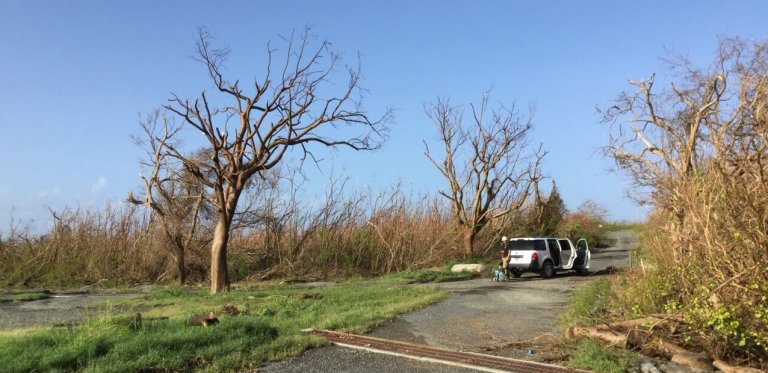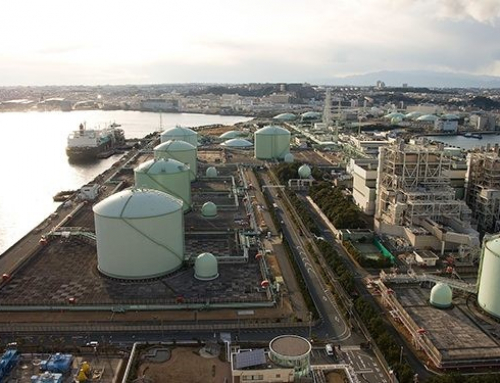 In 2017 Hurricane Maria stripped the trees of their leaves. Image: By US Fish & Wildlife Service SE Region, via Wikimedia Commons
In 2017 Hurricane Maria stripped the trees of their leaves. Image: By US Fish & Wildlife Service SE Region, via Wikimedia Commons
This article first appeared on Climate News Network.Net
by Tim Radford
More greenhouse gases mean worse tropical winds and fiercer storms. That could mean more forest damage . . . and more greenhouse gas emissions . . .
Worse tropical winds will spell worse danger to forests, in a cycle that feeds on itself. Hurricane Maria, which in 2017 slammed into Puerto Rico, shut down the electricity supply for the entire US island of 3.3 million people, and claimed almost 3,000 lives. And it also killed or damaged at least 20 million trees, or possibly 40 million.
If what happened in the track of Maria is a pointer to the future, then hurricanes, typhoons and tropical cyclones will join drought, wildfire and men with chainsaws as a new threat to the world’s tropical forests, the biggest absorbers of carbon on the terrestrial surface.
Living forests absorb carbon. Dying and decaying trees release greenhouse gases. The damage by Maria has already been estimated to have released 5.75 million tonnes of carbon to the atmosphere. This is about one-fortieth of all the carbon taken up by all the forests in the US.
“The expected changes in hurricane winds and rainfall may have profound consequences for the long-term resilience of tropical forests in the North Atlantic basin”
Hurricanes are linked with rising sea surface temperatures. Researchers have been warning for decades that in a warming world, extremes of heat, drought, flood and windstorm will become more destructive. So Hurricane Maria could be a taste of things to come.
“These hurricanes are going to kill more trees,” said Maria Uriarte, of the Earth Institute of Columbia University. “They’re going to break more trees. The factors that protected many trees in the past will no longer apply. Forests will become shorter and smaller because they won’t have time to regrow, and they will be less diverse.”
Maria blew into Puerto Rico in October 2017, with winds of up to 250 kms an hour. It dropped 500 mm of rain to become the island’s worst storm for 90 years.
To make their estimate of the destruction, Professor Uriarte and colleagues surveyed a 16-hectare plot of the island’s El Yunque national forest near the capital, San Juan: a plot that has been monitored after violent windstorm assault in 1989 by Hurricane Hugo and then in 1998 by Hurricane Georges.
Much fiercer impact
They report in the journal Nature Communications that Hurricane Maria killed twice as many trees outright as previous storms, and snapped more than three times as many trunks. Some species experienced breakage rates of up to 12 times that of previous hurricanes. Among them, and unexpectedly, were some of the slowest-growing, most valuable hardwoods. About half of all trees with broken trunks are expected to die within two or three years.
Some species survived well: among them the sierra palm, a tree able to bend with the wind, and if stripped sprout again from the top. Such species could be the inheritors of future hurricanes and grow quickly to take advantage of cleared forest space. So future forests could be dominated by shorter, and less diverse, foliage.
And the future is unpromising. Atlantic Ocean sea surface temperatures are rising, and climate simulations predict that by 2100 the highest sustained hurricane winds could increase by 15%. Warmer air can hold more moisture, so rainfall near storm centres could increase by 20%. Extreme winds fell trees; rain destabilises soil and makes uprooting easier.
“Maria transformed tropical forests across the island into leafless tangles of damaged and downed trees,” the researchers write. And they warn: “The expected changes in hurricane winds and rainfall may have profound consequences for the long-term resilience of tropical forests in the North Atlantic basin.” − Climate News Network
About Tim Radford: Tim Radford, a founding editor of Climate News Network, worked for The Guardian for 32 years, for most of that time as science editor. He has been covering climate change since 1988.




